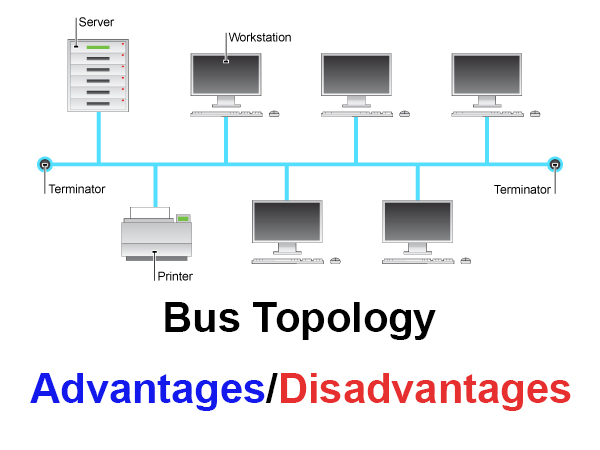
Advantages and disadvantages of bus topology
How computers are connected in the network is known as network topology. Bus topology is also a type of network topology. Definition of bus topology: A type of topology in which all the workstations, printers, servers, scanners, and laptops are connected to a common cable. The common cable is also known as a bus. The cable which is used to connect computers is known as coaxial cable. When [...]
How computers are connected in the network is known as network topology. Bus topology is also a type of network topology.
Definition of bus topology:
A type of topology in which all the workstations, printers, servers, scanners, and laptops are connected to a common cable. The common cable is also known as a bus. The cable which is used to connect computers is known as coaxial cable.
When the data is sent from any computer then it is broadcast to all the computers. The data contains Mac address also. So when data reach the destination computer then if the mac address match then data is received but if the mac address of the destination computer is different then the data is forwarded to other computers. When no mac address match then data reach to the end of bus cable and bounce back. To solve bouncing of data, terminators are used at both ends of the cable as shown in the diagram below.

Every computer and devices communicate with each other through the common bus. The computers and devices which are connected through the bus are also known as nodes. All the nodes in the bus topology can send and receive data packets once meaning only one node can transfer/receive data at a time and other nodes have to wait till the data is transferred or received.
The idea of the bus was introduced in the 1960s when the nodes connect through a cable. It is an old method of connecting computers in LAN (local area network) as compared to other network topologies.
Let’s discuss some pros and cons of bus topology.
Advantages of bus topology
Low cost:
Only one limited length of coaxial cable is needed to make the connection between computers. Coaxial cable is also inexpensive as compared to fiber optics. The setup cost of bus topology is also low as compared to mesh and star topology.
Adding a new node:
It is easy to add new computers and devices to the network. The newly added device can start working as it is and not extra setup of the network is needed. The two cables are joined by a connector to add a new computer to the network. It is also easy to remove any node and network performance will not affect removing any node.
Less cable length:
In a bus topology, the length of the cable is less as compared to the star topology. The data is transferred easily if the cable length is small.
Hub and switch:
There is no need for a hub and switch to connect computers. All nodes are connected via coaxial cable. A print server and file server can be added to the network through the cable as well.
Disadvantages of bus topology
Terminator is required:
Terminator is necessary for making network in bus topology. If a terminator is not added then data is bounced back and collide with other data of computers.
Troubleshooting:
If there occurs any error in the network then it is difficult to judge in which location the problem is. If the cable breaks then the whole network will stop working.
Maintenance cost:
On increasing the number of nodes connecting to the network the problem of maintenance is created. Bus topology works fine for few computers but adding more computers creates a problem. As only one computer can send a message at a time so wait time may increase if there are many computers connected.
Not good for high traffic:
Bus topology can only work fine for a small number of computer and it is not ideal for large traffic of data. On adding more nodes the performance of the network becomes slow.
Network security:
As all the computers receive the signals from the source computer so it is not good in terms of security. Any computer can read the data transferred in the network and hackers can easily get data by connecting to the network.
Examples of bus topology
- Connecting computers, printers, and scanners in an office room
- Connecting workstation and servers in the computer lab
- Computer networking in the home
- Making client-server network between nearby rooms
Share this article
Written by : Junaid Rehman
I am a blogger and freelance web developer by profession. I love to blog and learn new things about programming and IT World.
Follow us
A quick overview of the topics covered in this article.
Latest articles
December 5, 2025
December 5, 2025
December 5, 2025
December 5, 2025
December 5, 2025









